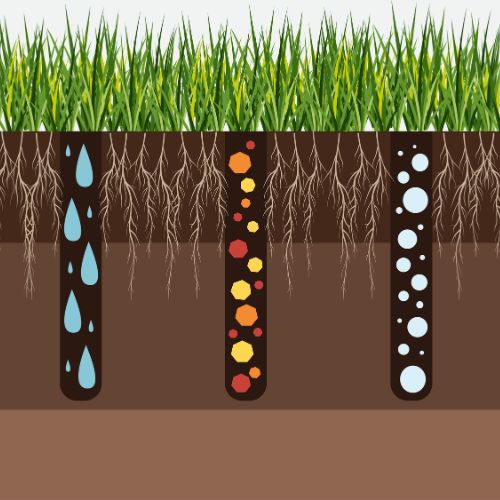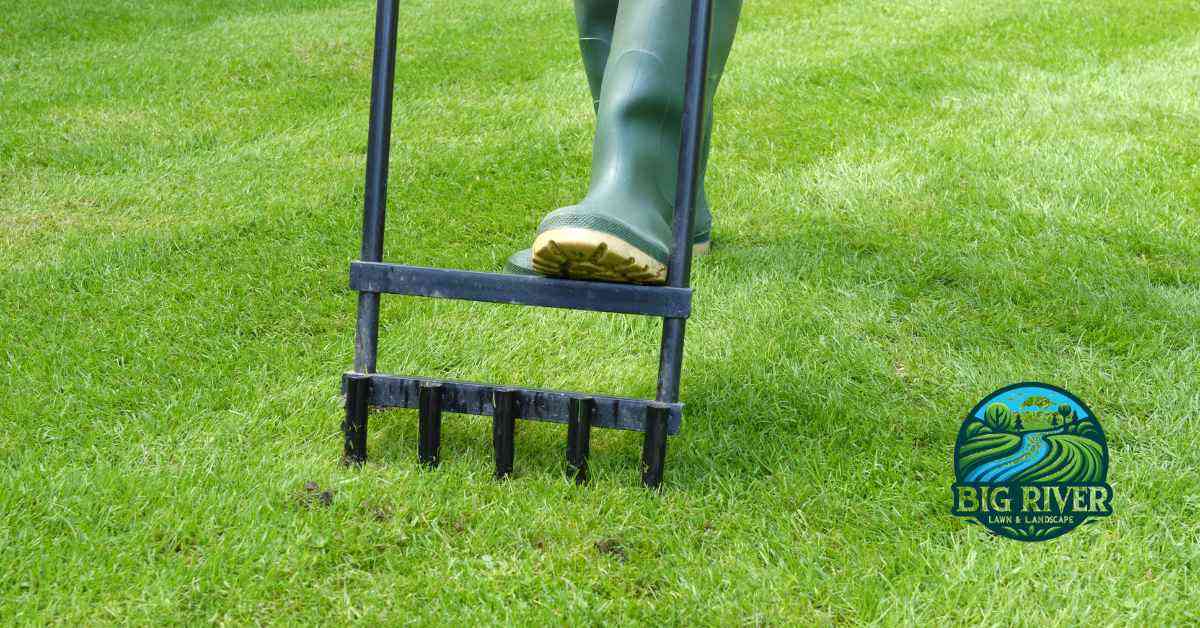Maintaining a lush, vibrant lawn requires more than regular mowing and watering. One often overlooked yet essential practice is lawn aeration. By perforating the soil with small holes, aeration facilitates the flow of air, water, and nutrients to the grassroots, promoting optimal growth and vitality. Before knowing the benefits of lawn aeration, check out what aeration is:
What is Aeration
Aeration is a lawn care practice that involves mechanically removing small plugs of soil from the lawn. This process helps alleviate soil compaction, improves root development, and enhances overall turf health. It allows air, water, and nutrients to penetrate deep into the soil, reaching the grassroots where they are needed most. By creating channels for essential elements to move freely within the soil, aeration creates an environment conducive to healthy turf growth and vitality. So, the importance of aerating lawns undeniably fosters optimal turf health and ensures a vibrant, resilient landscape.
Lawn Aeration is typically performed using specialized equipment such as core aerators or spike aerators. Core aerators remove small plugs of soil from the lawn, while spike aerators puncture the soil with solid tines. Both methods provide benefits, with core aeration more effective at relieving soil compaction and promoting better airflow. Overall, aeration is a fundamental practice offering various benefits of aerating lawns for maintaining a beautiful, resilient lawn that can withstand environmental stresses and thrive year-round.
The Top 10 Benefits of Lawn Aeration You Must Know
Lawn aeration stands as a cornerstone practice in lawn care, offering many benefits of aerating lawns that contribute to turf’s health, vibrancy, and longevity. It’s more than just poking holes in the ground; it’s about nurturing the very foundation upon which your lawn thrives. By understanding the intricate advantages of aeration, you embark on a journey towards cultivating a verdant carpet of grass that not only enhances the aesthetic appeal of your property but also fortifies it against various environmental stresses.
As the seasons wax and wane, your lawn endures many challenges, from compacted soil and suffocating thatch to invasive weeds and moisture imbalance. Amidst these trials, aeration emerges as a beacon of hope, offering a transformative solution to revitalize your lawn from the roots up. Through this process, your turf receives fresh air as the soil’s natural vitality is reignited, nurturing the grassroots and fostering a robust foundation for lush growth. So, what are the benefits of aerating your lawn? Here are the top 10 benefits of professional lawn aeration:
1. Improved Oxygen Circulation
Aeration plays a crucial role in enhancing oxygen circulation within the soil, which is essential for the health of your lawn. As soil compacts over time, it restricts air movement and suffocates the grassroots. Aeration creates channels in the soil, allowing oxygen to penetrate deep into the root zone, promoting aerobic microbial activity and facilitating nutrient uptake. This increased oxygen circulation stimulates root growth and metabolism, leading to stronger, healthier turf better equipped to withstand environmental stresses.
Furthermore, adequate oxygen levels in the soil promote the decomposition of organic matter, reducing thatch buildup and preventing anaerobic conditions that can harbor harmful pathogens. Oxygen is also vital for photosynthesis, where grass plants convert sunlight into energy for growth and development. By improving oxygen circulation, aeration fosters a robust and resilient lawn that thrives in diverse environmental conditions, from scorching summer heat to freezing winter temperatures. So, it is the major importance of aerating lawns.
2. Enhanced Nutrient Absorption
In addition to improving oxygen circulation, aeration facilitates better absorption of nutrients by the grassroots, promoting overall lawn vitality and resilience. When soil becomes compacted, it restricts the movement of water and nutrients, depriving the grassroots of essential elements for growth. Aeration helps break up compacted soil, creating pathways for nutrients to move freely within the soil profile and reach the root zone more efficiently. This enhanced nutrient absorption promotes healthy turf growth, strengthens root systems, and increases the lawn’s ability to recover from drought, disease, and foot traffic.
Moreover, improved nutrient uptake leads to greener, more vibrant turf with enhanced resistance to pests and diseases. By ensuring that grassroots receive the essential nutrients they need, aeration helps maintain a balanced and healthy soil ecosystem, supporting beneficial microbial activity and nutrient cycling. Ultimately, the enhanced nutrient absorption provided by aeration contributes to your lawn’s long-term health and sustainability and is of major importance to aeration, ensuring a beautiful and resilient landscape for years to come.
3. Reduced Soil Compaction
Aeration is highly effective in reducing soil compaction, a common issue in many lawns that can hinder root penetration and water absorption, so soil aeration is important. Soil compaction occurs over time due to heavy foot traffic, vehicle parking, and soil settling. Compacted soil restricts the movement of air, water, and nutrients, leading to shallow root systems and poor turf health. Aeration breaks up compacted layers by removing soil cores or creating channels with solid tines, allowing roots to penetrate deeper into the soil and access essential resources. This promotes stronger root growth, improved nutrient uptake, and enhanced drought resistance, resulting in a healthier and more resilient lawn.

Moreover, improved nutrient uptake leads to greener, more vibrant turf with enhanced resistance to pests and diseases. By ensuring that grassroots receive the essential nutrients they need, aeration helps maintain a balanced and healthy soil ecosystem, supporting beneficial microbial activity and nutrient cycling. Ultimately, the enhanced nutrient absorption provided by aeration contributes to your lawn’s long-term health and sustainability and is of major importance to aeration, ensuring a beautiful and resilient landscape for years to come.
4. Enhanced Water Infiltration
In addition to improving oxygen circulation and nutrient absorption, aeration plays a crucial role in enhancing water infiltration into the soil. Proper water infiltration is essential for maintaining healthy turf growth and preventing water runoff, erosion, and waterlogging. Compacted soil creates a barrier that prevents water from penetrating deep into the root zone, leading to shallow root systems and increased vulnerability to drought stress. By removing soil cores or creating channels, aeration breaks up compacted layers, allowing water to infiltrate more effectively and reach the grassroots where it is needed most. This promotes deeper root growth, improved water retention, and enhanced drought resistance, resulting in a healthier and more resilient lawn. So, these are the benefits of fall lawn aeration.
Furthermore, enhanced water infiltration helps reduce surface runoff and erosion, preserving soil structure and preventing nutrient loss. When water cannot penetrate the soil, it accumulates on the surface, increasing the risk of runoff during heavy rainfall or irrigation. This runoff washes away valuable topsoil and carries nutrients and pollutants into waterways, contributing to environmental degradation. Aeration improves water infiltration, allowing excess water to percolate into the soil.
5. Promotion of Microbial Activity
Aeration stimulates microbial life in the soil, which is essential for nutrient recycling and disease suppression. Microbes play a crucial role in breaking down organic matter, releasing nutrients essential for plant growth. By creating oxygen-rich environments and improving soil structure, aeration fosters the proliferation of beneficial soil microbes, such as bacteria, fungi, and earthworms. These microbes help decompose thatch, recycle nutrients, and suppress harmful pathogens, contributing to overall soil health and fertility. So, aeration is important for happy laws. Additionally, microbial activity enhances soil aggregation, creating a stable soil structure that promotes root growth and water infiltration. Aeration promotes a balanced and thriving soil ecosystem by promoting microbial activity, supporting healthy turf growth and minimizing the need for chemical fertilizers and pesticides.
6. Thatch Decomposition
Thatch buildup is a common problem in many lawns, consisting of a layer of dead grass, roots, and other organic matter that accumulates on the soil surface. Excessive thatch can prevent water, air, and nutrients from reaching the grassroots, leading to shallow root systems and increased susceptibility to diseases and pests. Aeration helps break down thatch buildup by introducing oxygen into the soil and stimulating microbial activity. So, take the benefits of aerating your lawn. As soil microbes decompose organic matter, they help reduce thatch thickness and promote a healthier soil environment. By incorporating aeration into your lawn care routine, you can effectively manage thatch buildup, improve soil structure, and promote healthy turf growth.
7. Improved Seed Germination
Thatch buildup is a common problem in many lawns, consisting of a layer of dead grass, roots, and other organic matter that accumulates on the soil surface. Excessive thatch can prevent water, air, and nutrients from reaching the grassroots, leading to shallow root systems and increased susceptibility to diseases and pests. Aeration helps break down thatch buildup by introducing oxygen into the soil and stimulating microbial activity. So, take the benefits of aerating your lawn. As soil microbes decompose organic matter, they help reduce thatch thickness and promote a healthier soil environment. For those who are considering professional assistance to manage their lawn’s health, exploring specialized services can be a beneficial step towards ensuring thorough and effective aeration. By incorporating aeration into your lawn care routine, you can effectively manage thatch buildup, improve soil structure, and promote healthy turf growth.
8. Enhanced Weed Control
Aeration helps suppress weed growth by promoting a denser, healthier turf that can outcompete weeds for resources. When soil becomes compacted, it creates ideal conditions for weed seeds to germinate and establish themselves. By aerating the soil and promoting healthy root growth, you create a strong, vigorous turf that can effectively crowd out weeds and reduce their establishment. Additionally, aeration helps improve the effectiveness of herbicides by allowing them to penetrate deeper into the soil and reach weed roots more effectively. By incorporating aeration into your lawn care routine, you can effectively manage weed populations and maintain a beautiful, weed-free lawn, which is the importance of soil aeration.
9. Overall Aesthetic and Long-Term Health Benefits
Regular lawn aeration yields cumulative benefits, resulting in a beautiful, resilient lawn that enhances the curb appeal of your property. Aeration improves soil structure, promotes healthy root growth, and enhances nutrient uptake, leading to a thicker, greener lawn with fewer bare patches and weeds. By addressing common lawn problems such as soil compaction, thatch buildup, and poor drainage, aeration creates a healthier, more sustainable lawn that can withstand environmental stresses and thrive year-round. Investing in regular aeration ensures long-term health and beauty for your lawn, providing you with a lush, vibrant outdoor space to enjoy for years to come.
10. Increased Tolerance to Environmental Stress
Aerated lawns exhibit greater tolerance to environmental stresses such as heat, cold, and foot traffic. Soil compaction restricts root growth and inhibits the lawn’s ability to absorb water and nutrients, making it more susceptible to stressors such as drought and disease. By aerating the soil, you create channels for air, water, and nutrients to penetrate deep into the root zone, promoting healthier root systems and improved stress tolerance. This enables your lawn to withstand environmental stresses more effectively, maintaining its lush green appearance even during periods of extreme weather or heavy use. Additionally, aerated lawns recover more quickly from stressors such as drought or pest infestations, ensuring long-term health and vitality for your outdoor space.
Final Thoughts
In conclusion, lawn aeration has multifaceted benefits, ranging from improved nutrient absorption and water infiltration to enhanced weed control and stress tolerance. Incorporating aeration into your lawn care routine is essential for maintaining a lush, healthy lawn that enhances the beauty of your outdoor space.
FAQs On Benefits of Lawn Aeration
What Is the Main Disadvantage of the Aeration Process?
While lawn aeration offers numerous benefits, the main disadvantage is that it can temporarily disrupt the appearance of your lawn, leaving small plugs of soil on the surface. However, this is a minor inconvenience compared to the long-term benefits it provides.
Is Aeration Really Necessary?
Yes, aeration is necessary for maintaining a healthy lawn, especially in areas with compacted soil or heavy thatch buildup. It promotes root growth, improves nutrient uptake, and enhances turf health.
When Should You Not Aerate Your Lawn?
Avoid aerating your lawn during periods of extreme drought or when the soil is excessively wet. Additionally, newly sodded or seeded lawns should not be aerated until they are well-established. For more in-depth guidance on maintaining your lawn throughout the year, including when it’s best to undertake specific tasks, consider exploring our comprehensive guide on the top lawn care tips and tricks.
Does Aeration Help With Weeds?
Yes, aeration helps control weeds by promoting a denser turf that can outcompete weed growth. However, it may not eliminate existing weeds and should complement other weed control strategies for optimal results.
Do Aerating Shoes Really Work?
Aerating shoes can be effective for lightly aerating small areas of turf. However, for larger lawns or areas with compacted soil, professional core aeration using specialized equipment is recommended for more thorough results.
What Are the Benefits of Aeration?
In short, aeration improves oxygen circulation, relieves soil compaction, promotes deeper root growth, enhances nutrient absorption, stimulates microbial activity, and ultimately fosters a healthier, more resilient lawn.



